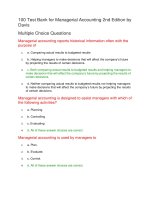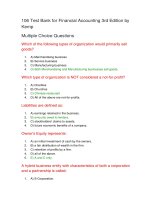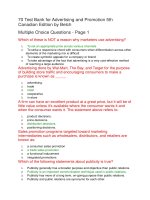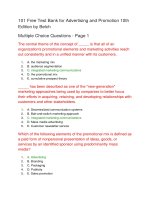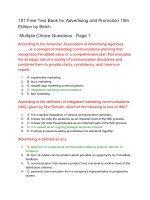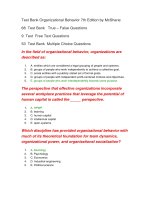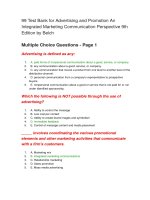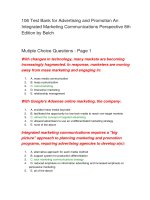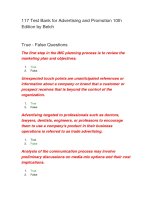99 test bank for advertising and promotion an integrated marketing communication perspective 9th edition by belch
Bạn đang xem bản rút gọn của tài liệu. Xem và tải ngay bản đầy đủ của tài liệu tại đây (134.96 KB, 23 trang )
99 Test Bank for Advertising and Promotion An
Integrated Marketing Communication Perspective 9th
Edition by Belch
Multiple Choice Questions - Page 1
Advertising is defined as any:
1.
2.
3.
A. paid forms of nonpersonal communication about a good, service, or company.
B. any communication about a good, service, or company.
C. any communication that moves a product from one level to another level of the
distribution channel.
4. D. personal communication from a company's representative to prospective
buyers.
5. E. nonpersonal communication about a good or service that is not paid for or run
under identified sponsorship.
Which the following is NOT possible through the use of
advertising?
1.
2.
3.
4.
5.
A. Ability to control the message
B. Low cost per contact
C. Ability to create brand images and symbolism
D. Immediate feedback
E. Control of message content and media placement
_____ involves coordinating the various promotional
elements and other marketing activities that
communicate with a firm's customers.
1.
2.
3.
4.
5.
A. Marketing mix
B. Integrated marketing communications
C. Relationship marketing
D. Sales promotion
E. Mass media advertising
______ is the coordination of all seller-initiated efforts to set
up channels of information and persuasion to sell
goods and services.
1.
2.
3.
4.
5.
A. Publicity
B. Advertising
C. Organizational communication
D. Promotion
E. Marketing
Which of the following is NOT an element of the traditional
promotional mix?
1.
2.
3.
4.
5.
A. Packaging
B. Advertising
C. Personal selling
D. Sales promotion
E. Public relations
Terms such as new advertising, orchestration, and seamless
communication have been used to describe:
1.
2.
3.
4.
5.
A. the marketing mix.
B. integrated marketing communications.
C. the promotion mix.
D. relationship marketing.
E. the 4 A's.
The central theme of the concept of _____ is that all of an
organization's marketing and promotional elements
and activities communicate consistently and in a
unified manner with its customers.
1.
2.
3.
4.
5.
A. the marketing mix
B. exchange
C. integrated marketing communications
D. the promotional mix
E. relationship marketing
Advocates of integrated marketing communications argue
that:
1.
2.
3.
4.
5.
A. firms should communicate with its customers primarily through media
advertising.
B. nonpersonal communications is more effective than personal communications.
C. package design is the most important way of communicating with customers.
D. firms should communicate with its customers primarily through one-on-one
communication techniques.
E. firms should develop a total marketing communications strategy.
Price, product, place and promotion together form the:
1.
2.
3.
4.
5.
A. value.
B. promotional mix.
C. marketing mix.
D. integrated marketing communication.
E. distribution channel.
_____ has been described as one of the "new-generation"
marketing approaches being used by companies to
better focus their efforts in acquiring, retaining, and
developing relationships with customers and other
stakeholders.
1.
2.
3.
4.
5.
A. Marketing Mix
B. Promotion
C. Integrated Marketing Communications
D. Mass media advertising
E. Mass marketing
"The 4As" stands for:
1.
2.
3.
4.
5.
A. Association for Awareness of Advertising and Action.
B. American Association of Advertising Agencies.
C. Asian Association for Advertising Agencies.
D. Advertising aimed at Americans, Africans and Asians.
E. Advertising Agencies Association of America.
Integrated marketing communications requires a "big
picture" approach to planning marketing and
promotion programs, requiring advertising agencies to
develop a(n):
1.
2.
3.
4.
A. alternative approach for each media method.
B. support system for production differentiation.
C. total marketing communications strategy.
D. reduced emphasis on information advertising and increased emphasis on
persuasive marketing.
5. E. different marketing mix for the same product in different countries.
Product, price, promotion, and _____ are the 4Ps of the
marketing mix.
1.
2.
3.
4.
5.
A. people
B. place
C. package
D. print
E. privilege
The basic elements that are used to accomplish an
organization's marketing communication objectives
are referred to as:
1.
2.
3.
A. the marketing mix.
B. marketing strategy tools.
C. persuasive marketing mix.
4.
5.
D. the promotional mix.
E. public relations.
Prior to the development of integrated marketing
communications, the promotional function in most
companies was dominated by:
1.
2.
3.
4.
5.
A. advertising.
B. sales promotion.
C. public relations.
D. publicity.
E. direct marketing.
_____ is defined as any paid form of nonpersonal
presentation of ideas, goods, or services by an
identified sponsor using predominantly mass media
communication.
1.
2.
3.
4.
5.
A. Advertising
B. Personal selling
C. The promotional mix
D. Publicity
E. Sales promotion
Traditionally, _____ has been the cornerstone of brandbuilding efforts.
1.
2.
3.
4.
5.
A. interactive media
B. mass-media advertising
C. public relations
D. product placement
E. personal selling
The best-known and most widely discussed form of
promotion is:
1.
2.
3.
4.
5.
A. personal selling.
B. sales promotion.
C. direct marketing.
D. advertising.
E. publicity/public relations.
Which promotional mix would a firm use if it wanted to reach
a large consumer audience while keeping cost per
contact low and create a symbolic image or appeal for
a new brand?
1.
2.
A. Advertising
B. Personal selling
3.
4.
5.
C. Sales promotion
D. Coupons
E. Door-to-door selling
Which of the following is true about integrated marketing
communication (IMC)?
1.
2.
3.
4.
5.
A. It is a tactical integration of various communication activities.
B. Audience does not form an important part of the IMC process.
C. Employees are not seen as an important part of the IMC process.
D. IMC is viewed as on ongoing strategic business process.
E. IMC simply involves bundling promotional mix elements together.
Which of the following is true about advertising?
1.
2.
A. It attempts to create a personal relationship with the customers.
B. The nature and purpose of advertising is usually the same across various
industries.
3. C. It is a valuable tool for building company and brand image.
4. D. Advertising is used only for the promotion of mass consumer products.
5. E. One disadvantage of advertising is that it gets too personal with consumers.
To respond to media fragmentation, marketers are moving
away from mass marketing and engaging in:
1.
2.
3.
4.
5.
A. mass media communication.
B. television advertising.
C. micromarketing.
D. mass production.
E. relationship management.
_____ is the sum of all points of encounter or contact that
consumers have with the brand, and it extends beyond
the experience or outcome of using it.
1.
2.
3.
4.
5.
A. Touch point
B. Brand identity
C. Marketing mix
D. Customization
E. Interactive marketing
_____ is the customer's perception of all the benefits of a
product or service weighed against all the costs of
acquiring and consuming it.
1.
2.
3.
4.
5.
A. Cost efficiency
B. Information
C. Range
D. Value
E. Exposure
_____ is a system of marketing by which organizations
communicate directly with target customers to
generate a response and/or a transaction.
1.
2.
3.
4.
5.
A. Advertising
B. Sales promotion
C. Direct marketing
D. Publicity
E. Public relations
Which of the following is an example of a marketing
exchange?
1.
2.
3.
4.
A. The waitress gave Cyrus a menu, and he placed his food order.
B. Griffin helped Mandy replace the air filter in her lawn mower.
C. Ken and Maggie gave their son an MP3 player for his birthday.
D. In return for painting her fence, Mrs. Maloney gave Larry a box of homemade
fudge.
5. E. Jenny asked Melisa if she could borrow her pen for a while since her pen had
stopped working.
_____ is a concept of marketing communications planning
that recognizes the added value of a comprehensive
plan that evaluates the strategic role of a variety of
communication disciplines and combines them to
provide clarity, consistency, and maximum impact.
1.
2.
3.
4.
5.
A. Marketing mix
B. Buzz marketing
C. Exchange
D. Integrated marketing communications
E. Promotional planning
Which of the following statements is true about marketing?
1.
2.
3.
4.
5.
A. Most marketers are seeking a one-time exchange or transaction with their
customers.
B. The focus of production-driven companies is on developing and sustaining
relationships with their customers.
C. Successful companies recognize that creating and delivering value to their
customers is extremely important.
D. Though marketing plays an important role in developing relationships with
customers, it cannot do much to maintain them.
E. By definition, a marketing transaction has to involve the exchange of money.
Advertising done by manufacturers of well-known brands on
a nationwide basis or in most regions of the country is
known as _____ advertising.
1.
2.
3.
4.
5.
A. primary demand
B. trade
C. consumer
D. national
E. retail
The goal of an integrated marketing communications
program is to:
1.
2.
3.
4.
5.
A. have all of a company's marketing and promotional activities project a
consistent unified image to its customers.
B. control all facets of a product's distribution.
C. communicate with customers primarily through advertising.
D. have complete control over all the channel partners in the distribution channel.
E. create a brand image so strong that it destroys all of its competition.
Which of the following is a characteristic of advertising as a
form of promotion?
1.
2.
3.
4.
5.
A. Low cost per contact
B. Non-paid form of promotion
C. The sponsor or advertiser is not identified
D. Immediate feedback and capability to close sales
E. Makes use of non-traditional media
99 Free Test Bank for Advertising and Promotion
An Integrated Perspective 9th Edition by Belch
Multiple Choice Questions - Page 2
Sales promotion programs targeted toward marketing
intermediaries such as wholesalers, distributors, and
retailers are known as:
1.
2.
3.
4.
5.
A. consumer-oriented sales promotion.
B. trade-oriented sales promotion.
C. functional inducement.
D. direct marketing.
E. integrated promotions.
_____ advertising is done by local merchants to encourage
consumers to shop at a specific store, use a local
service, or patronize a particular establishment.
1.
2.
3.
4.
5.
A. Trade
B. Professional
C. Direct response
D. Retail
E. National
Retail/Local advertising often takes the form of:
1.
2.
3.
4.
5.
A. trade advertising.
B. selective-demand advertising.
C. bait and switch advertising.
D. direct-action advertising.
E. indirect response advertising.
Which of the following statements is true about direct
marketing?
1.
2.
3.
4.
5.
A. Traditionally, it has not been considered an element of the promotional mix.
B. It is synonymous with direct mail.
C. Indirect-response advertising is considered as one of its major tools.
D. It is seldom, if ever, used by companies that have an external sales force.
E. It does not exist beyond direct mail and mail-order catalogs.
DocStock, a company that manufactures stethoscopes, has
placed an ad in DocsMag, a magazine targeted at
doctors. This is an example of:
1.
2.
3.
4.
5.
A. business-to-business advertising.
B. trade advertising.
C. professional advertising.
D. primary-demand advertising.
E. direct action advertising.
Stylo, a perfume manufacturing company, spends about
$1,000,000 annually in order to advertise and remind
its customers in the United States about its company,
brand, its features, benefits, uses, and mainly to
reinforce its image and attract customers to purchase
its products. Which type of advertising is it making use
of?
1.
2.
3.
A. National advertising
B. Primary demand advertising
C. Trade advertising
4.
5.
D. Business-to-business advertising
E. Professional advertising
Coldwater Creek is a retailer that uses its website to promote
and sell new merchandise. Coldwater Creek views the
Internet as a(n) _____ medium.
1.
2.
3.
4.
5.
A. interactive
B. indirect
C. primary-demand
D. print
E. traditional
Advertising done by Target, Kohl's, and Macy's for the
purpose of building store traffic and encouraging
consumers to make a purchase now is known as _____
advertising.
1.
2.
3.
4.
5.
A. trade
B. facultative
C. cooperative
D. direct-action
E. direct-response
A used bookstore that runs an ad which announces a "12hour, everything must go" sale is using:
1.
2.
3.
4.
5.
A. homogeneous marketing.
B. direct-response advertising.
C. a direct-action promotion.
D. an indirect-response advertising.
E. bait and switch advertising.
Which of the following is true about retail advertising?
1.
2.
3.
4.
5.
A. It is done by large companies on a nationwide basis or in most regions of the
country.
B. It takes the form of direct-response advertising.
C. It is done to build store traffic and sales.
D. It designed to stimulate demand for the general product class or entire industry.
E. It is targeted to marketing channel members such as wholesalers, distributors,
and retailers.
Amul, a food product marketing organization, has come up
with new global ads that promote the benefits of
drinking milk as well as demonstrates the various uses
of milk. This is an example of:
1.
A. trade advertising.
2.
3.
4.
5.
B. primary-demand advertising.
C. secondary-demand advertising.
D. retail advertising.
E. professional advertising.
Which of the following is true about the Internet media?
1.
2.
3.
A. It is considered as traditional media.
B. It essentially allows for one-way communication.
C. It enables marketers to gather valuable personal information from customers
and prospects.
4. D. The effect of using Internet media can be closely and precisely measured by
advertising and other forms of promotion.
5. E. One major disadvantage of Internet media is that it cannot be integrated with
other media programs.
_____ advertising is targeted at individuals who influence the
purchase of goods and services used to make other
products.
1.
2.
3.
4.
5.
A. Professional
B. Primary demand
C. Retail
D. Business-to-Business
E. Direct-response
Starbucks has developed apps for the iPhone which allow
customers to share drink recipes, find the nearest
Starbucks, look up nutritional information, and
manage their Starbucks gift cards. This is an example
of ¬¬_____ marketing.
1.
2.
3.
4.
5.
A. trade
B. direct
C. direct action
D. professional
E. interactive
Primary-demand advertising is designed to:
1.
2.
3.
4.
5.
A. draw particular attention to a particular branded item.
B. stimulate demand for a general product class or industry.
C. help launch a specific line extension.
D. compare two or more competitors in a real world situation.
E. create a market share gain for the industry leader.
The National Egg Coordination Committee has for years now
been promoting the benefits of eggs and their
importance in one's diet through its ads, which are
aired in many nations. Which type of advertising is it
making use of?
1.
2.
3.
4.
5.
A. National advertising
B. Professional advertising
C. Primary-demand advertising
D. Selective-demand advertising
E. Trade advertising
_____ advertising is targeted to marketing channel members
such as wholesalers, distributors, and retailers in
order to encourage them to stock more of a particular
brand.
1.
2.
3.
4.
5.
A. National
B. Selective-demand
C. Professional
D. Trade
E. Retail
_____ is a tool of direct marketing that is used to call
customers directly and attempt to sell the products
and services, or qualify them as sales leads.
1.
2.
3.
4.
5.
A. Advertising
B. Buzz marketing
C. Telemarketing
D. Direct response marketing
E. Door-to-door selling
Chicken of the Sea includes coupons in their magazine
advertisements. This is an example of:
1.
2.
3.
4.
5.
A. consumer-oriented sales promotion.
B. direct-response advertising campaign.
C. primary-demand advertising campaign.
D. trade-oriented sales promotion.
E. service-oriented sales promotion.
One of the major tools of direct marketing is ______
advertising, where a product is promoted through an
ad that encourages the consumer to purchase directly
from the manufacturer.
1.
2.
3.
4.
5.
A. direct-response
B. primary-demand
C. business-to-business
D. trade
E. selective-demand
Which of the following best describes selective-demand
advertising?
1.
2.
3.
4.
5.
A. Advertisement of ‘Complan' that compares its benefits against its competitor
‘Bournvita'.
B. Beef council stimulating the demand for beef through an ad.
C. Advertisement of Coca-Cola placed in progressive grocer, a trade magazine to
promote Coca-Cola to food store managers.
D. Lufthansa ad that appears in the newspapers all across the country.
E. Ad for a 3 day discount in a restaurant located in San Diego which appears in
the local newspaper.
Which of the following is an example of trade advertising?
1.
2.
3.
4.
5.
A. Advertisement of a health drink i.e. ‘Complan' that specifies the benefits of
drinking it.
B. The Silk Federation of Asia advertising the importance of silk and the various
purposes that it could be used for.
C. Advertisement of Coca-Cola placed in Progressive grocer, a magazine to
promote Coca-Cola to food store managers.
D. SouthWest Airlines ads that appears in the newspapers all across the country.
E. Ad for a 3 day discount in a restaurant located in a remote area in San Diego
which appears in the local newspaper.
The ad for the Bose Wave radio/CD player in Newsweek
magazine has a coupon that you can use to order the
radio/CD player, a toll-free number you can call to
place an order, and a website to place orders. This ad
is an example of _____ advertising.
1.
2.
3.
4.
5.
A. direct-response
B. primary-demand
C. business-to-business
D. trade
E. secondary demand
_____ advertising focuses on creating demand for a specific
company's brand.
1.
2.
3.
4.
5.
A. Primary-demand
B. Selective-demand
C. Trade
D. Secondary-demand
E. Industrial
Big bazaar, a supermarket in India, recently placed an ad in
the newspapers circulated in Bangalore city that it
would provide 10 vegetables at a flat rate of Rs.10 to
consumers from Monday to Wednesday between 1
p.m. and 3 p.m. at select locations in the Bangalore
city. Which of the following types of advertising did it
make use of?
1.
2.
3.
4.
5.
A. National advertising
B. Trade advertising
C. Retail advertising
D. Primary-demand advertising
E. Direct response advertising
Sales promotions targeted to the ultimate users of a product
such as sampling, coupons, contests, or sweepstakes
are known as:
1.
2.
3.
4.
5.
A. consumer-oriented sales promotion.
B. trade-oriented sales promotion.
C. direct marketing incentives.
D. public relations.
E. strategic promotions.
_____ includes those marketing activities that provide extra
value or incentives for purchasing a product such as
coupons and premiums.
1.
2.
3.
4.
5.
A. Direct marketing
B. Advertising
C. Public relations
D. Sales promotion
E. Brand equity
Ads for Wagner Brake Products, Champion spark plugs,
MOOG chassis parts, and Keystone wheels in Tire
Review, a journal written and published especially for
owners/operators of auto shops, are examples of
_____ advertising.
1.
2.
3.
4.
5.
A. retail
B. direct-response
C. business-to-business
D. direct - mail
E. primary-demand
Which of the following is an example of retail advertising?
1.
2.
3.
4.
5.
A. Advertisement of a health drink ‘Complan' that compares its benefits against its
competitor ‘Bournvita'.
B. Beef council stimulating the demand for beef through an ad.
C. Advertisement of Coca-Cola placed in Progressive grocer, a trade magazine to
promote Coca-Cola to food store managers.
D. Lufthansa ad that appears in the newspapers all across the country.
E. A newspaper ad for a 3 day discount in a restaurant located in the outskirts of
San Diego.
Bradford Exchange is a company that sells collectible plates.
If you order one plate from the company, you will
receive multiple mails each month providing you with
information of new issues and encouraging you to
place your order for additional plates. Given this
information, which promotional element does Bradford
Exchange depend upon?
1.
2.
3.
4.
5.
A. Advertising
B. Sale promotion
C. Direct marketing
D. Publicity
E. Pricing
99 Free Test Bank for Advertising and Promotion
An Integrated Perspective 9th Edition by Belch
Multiple Choice Questions - Page 3
Business-to-business marketers who sell expensive, risky,
and often complex products rely most heavily on
which of the following promotional tools?
1.
A. Print advertising
2.
3.
4.
5.
B. Coupons
C. Direct mail
D. Personal selling
E. Pricing
Which of the following touch points relate to unanticipated
references or information about a company or brand
that a customer or prospect receives from sources that
are beyond the control of the organization?
1.
2.
3.
4.
5.
A. Company created touch point
B. Intrinsic touch point
C. Extrinsic touch point
D. Unexpected touch point
E. Customer initiated touch point
The development of the advertising message that the
marketer wants to convey to its target audience is
called _____, and the determination of which
communications channels to use to deliver the
message is _____.
1.
2.
3.
4.
5.
A. creative strategy; media strategy
B. media strategy; message strategy
C. the marketing program; the communications program
D. the Five Cs; the 4 Ms
E. message strategy; channel strategy
Which of the following is true about public relations?
1.
2.
3.
4.
A. It is another name for publicity.
B. It is narrower in perspective than publicity.
C. Publicity is a tool used for public relations.
D. It uses a variety of tools such as sponsorship, publicity, special events etc.
except advertising.
5. E. It is a tool for publicity.
According to the planning model, the most involved and
detailed step of the promotional planning process is:
1.
2.
3.
4.
5.
A. reviewing the marketing plan and situation analysis.
B. determining the promotional budget.
C. developing the integrated marketing communications (IMC) program.
D. monitoring, evaluating, and controlling the promotional program.
E. determining the media strategy.
The first step in the IMC planning process is:
1.
2.
A. the situation analysis.
B. budget determination.
3.
4.
5.
C. a review of the marketing plan.
D. specification of communications objectives.
E. development of the promotional mix strategies.
Which of the following statements about publicity and public
relations is true?
1.
2.
3.
A. Publicity generally has a broader purpose and objective than public relations.
B. Publicity is the only tool used in a firm's public relations efforts.
C. Publicity is one of the most important communication techniques used in public
relations.
4. D. Publicity has more of a long term, on-going purpose than public relations.
5. E. Publicity and public relations are synonyms for each other.
What is the major advantage of personal selling over
advertising as a communication method?
1.
2.
3.
A. Personal selling generates more sales per dollar invested.
B. Personal selling improves the image of the firm.
C. Personal selling activates the receiver's selective processes, and advertising
does not.
4. D. Personal selling results in sales responses that are more difficult to measure
than those of advertising.
5. E. Personal selling is more persuasive because the communicator can judge the
sales prospect and modify his or her message accordingly.
_____ refers to each and every opportunity the customer has
to see or hear about the company and/or its brands or
have an encounter or experience with it.
1.
2.
3.
4.
5.
A. Marketing mix
B. Promotion
C. Moment of truth
D. Touch point
E. Brand equity
_____ is a promotional mix element that allows for direct
contact between a buyer and seller and allows a
message to be modified according to the needs or
reactions of the customer.
1.
2.
3.
4.
5.
A. Advertising
B. Direct mail
C. Public relations
D. Sales promotion
E. Personal selling
How does the integrated marketing communications (IMC)
plan approach differ from traditional approaches to
promotion?
1.
2.
3.
A. IMC puts more emphasis on advertising and less on sales promotion.
B. IMC puts more emphasis on sales promotion and less on advertising.
C. IMC recognizes that marketers must be able to use a wide range of marketing
and promotional tools to present a consistent image to target audiences.
4. D. IMC places barriers around the various marketing and promotional functions
and requires that they be planned and managed separately.
5. E. IMC predominately makes use of mass media communications in order to
attract and retain customers.
Which of the following statements describe a disadvantage
of publicity?
1.
2.
3.
A. Publicity is expensive to implement.
B. Publicity has relatively low credibility.
C. Publicity is not always under the control of the organization that reaps the
negative and positive benefits from it.
4. D. Publicity is not useful with a market segmentation strategy.
5. E. Publicity makes a market aggregation strategy ineffective.
According to the IMC planning model,
1.
2.
3.
4.
5.
A. promotional mix elements share a set of objectives and a strategy for meeting
these objectives.
B. objectives and strategies for each promotional mix element are based on
advertising goals.
C. budgeting is done only for advertising.
D. it is important to monitor, evaluate, and control the promotional program to
determine how well it is meeting communications objectives.
E. the internal and external situation analysis is done after the budget is
determined.
A lawsuit charged a mortgage lender with racism because it
allegedly charged African-American borrowers higher
rates than other borrowers. News of the lawsuit was
reported by the wire service, and it appeared in several
newspapers. This is an example of:
1.
2.
3.
4.
5.
A. sales detraction.
B. negative advertising.
C. cause selling.
D. negative publicity.
E. neutral publicity.
_____ is the management function that evaluates public
attitudes, identifies the policies and procedures of an
individual or organization with the public interest, and
executes a program of action to earn public
understanding and acceptance.
1.
2.
3.
4.
5.
A. Direct marketing
B. Publicity
C. Corporate affairs
D. Public relations
E. Sales promotion
_____ should be the guiding force for development of the
overall marketing communications strategy and of
objectives for each element of the promotional mix.
1.
2.
3.
4.
5.
A. Communication objectives
B. Sales objectives
C. Marketing objectives
D. Promotional objectives
E. Production objectives
Which of the following statements accurately describe how
mass communication differs from personal
communication?
1.
2.
A. To reach a large audience, interpersonal communication is faster.
B. Interpersonal communication messages are more easily adapted to the
receiver.
3. C. Mass communication has a greater ability to attract attention.
4. D. Cost per individual reached tends to be higher with mass communication.
5. E. Feedback tends to be more accurate with mass communication.
_____ is the process for planning, executing, evaluating, and
controlling the use of the various promotional-mix
elements to effectively communicate with target
audiences.
1.
2.
3.
4.
5.
A. Integrated advertising marketing
B. Integrated marketing communications management
C. Market auditing
D. Situation analysis
E. Communications process accounting
One of the primary advantages inherent in the use of
publicity is its:
1.
A. ability to be personalized.
2.
3.
4.
5.
B. credibility.
C. negligible variable costs.
D. tangibility.
E. ability to be closely controlled and monitored by the organization that is being
publicized.
A marketing plan usually includes:
1.
2.
3.
4.
5.
A. a corporate mission statement.
B. job descriptions and job specifications.
C. a media schedule.
D. a detailed situation analysis.
E. sales and market forecasts.
_____ refer to what is to be accomplished by the overall
marketing program and is stated in terms of sales,
market share, and profitability.
1.
2.
3.
4.
5.
A. Communication objectives
B. Marketing objectives
C. Advertising platforms
D. Segmentation approaches
E. External analysis factors
_____ is a form of person-to-person communication in which
a seller attempts to assist and/or persuade prospective
buyers to purchase the company's product or service
or to act on an idea.
1.
2.
3.
4.
5.
A. Advertising
B. Sales promotion
C. Direct marketing
D. Interactive marketing
E. Personal selling
A review of a movie in Newsweek magazine or on the Good
Morning America television show is an example of:
1.
2.
3.
4.
5.
A. personal selling.
B. publicity/public relations.
C. direct marketing.
D. advertising.
E. media-selling.
_____ refer to what the firm seeks to accomplish with its
promotional program and are often stated in terms of
the nature of the message to be communicated.
1.
2.
A. Communication objectives
B. Sales quotas
3.
4.
5.
C. Advertising platforms
D. Shaping goals
E. External analysis factors
Kerry is asked to evaluate the strengths and weaknesses of
each IMC tool being used by the agency and make
recommendations to plan and execute
communications with target audiences. Kerry is
engaged in:
1.
2.
3.
4.
5.
A. survey research strategies.
B. account-client articulation agreements.
C. integrated marketing communications management.
D. derived demand analysis.
E. efficient synergy management.
_____ are planned marketing communication messages
created by the company such as advertisements,
websites, news/press releases, packaging, brochures,
and sales promotion etc.
1.
2.
3.
4.
5.
A. Distributive touch points
B. Public relations
C. Company created touch points
D. Intrinsic touch points
E. Extrinsic touch points
What is the next stage in the IMC planning process, once
marketing and communication objectives have been
set?
1.
2.
3.
4.
5.
A. Budget determination
B. Implementation of those objectives
C. Media selection scheduling
D. Recruitment of marketing and promotion personnel
E. Development of the IMC program
_____ is nonpersonal communication neither directly paid
for nor run under identified sponsorship.
1.
2.
3.
4.
5.
A. Advertising
B. Sales promotion
C. Publicity
D. Public relations
E. Personal selling
Joy calls a Samsung store in order to find out about the new
Samsung Wave S8500. The customer service
department personnel of Samsung emails him the
entire product details in a very organized manner
along with the price of the product and other special
specifications as requested by Joy. Which type or
category of touch point has been discussed here?
1.
2.
3.
4.
5.
A. Company created touch point
B. Intrinsic touch point
C. Extrinsic touch point
D. Unexpected touch point
E. Customer-initiated touch point
Which of the following statements describe the difference
between publicity and advertising?
1.
2.
3.
4.
A. Advertising is done by manufacturers, and publicity is done by retailers.
B. Advertising is personal, and publicity is nonpersonal in nature.
C. Advertising is paid for by the sponsoring organization, and publicity is not.
D. Advertising is never institutional (i.e., promoting the company itself), and
publicity usually is institutional in character.
5. E. Advertising typically utilizes mass media, and publicity does not.
Because of the perceived objectivity of the source, which of
the elements of the promotional mix is usually
regarded as most credible?
1.
2.
3.
4.
5.
A. Advertising
B. Publicity
C. Packaging
D. Sales promotion
E. Direct marketing
The _____ is a written document that describes the overall
marketing strategy and programs developed for an
organization, product line, or brand.
1.
2.
3.
4.
5.
A. promotional plan
B. marketing plan
C. communications plan
D. marketing audit
E. situation analysis
_____ are interactions that occur with a company or brand
during the process of buying or using the product or
service.
1.
2.
3.
4.
5.
A. Intrinsic touch points
B. Company created touch points
C. Sales promotions
D. Extrinsic touch points
E. Seamless communications
The second stage of the IMC planning process is the:
1.
2.
3.
4.
5.
A. development of a mission statement.
B. development of marketing job descriptions.
C. promotional analysis.
D. development of an advertising plan.
E. preparation of a marketing plan.
The final stage of the IMC planning model is:
1.
2.
3.
4.
5.
A. budget determination.
B. the development of the media strategy.
C. analysis of communication process.
D. integrating creative strategies.
E. monitoring, evaluation, and control.
When the individual voted off of The Survivor, a reality
series, appears on David Letterman as a guest to
discuss the series and his or her role in the series, it is
an example of _____ for the CBS television show.
1.
2.
3.
4.
5.
A. advertising
B. publicity
C. sales promotion
D. personal selling
E. direct marketing
When an organization systematically plans and distributes
information in an attempt to control and manage the
nature of the publicity it receives and its image, it is
engaging in a function known as:
1.
2.
3.
4.
5.
A. image management.
B. advertising.
C. integrated marketing.
D. public relations.
E. sales promotion.
The promotional mix element that allows for the most
immediate and precise feedback from the customer is:
1.
2.
3.
4.
5.
A. advertising.
B. sales promotion.
C. public relations.
D. publicity.
E. personal selling.
